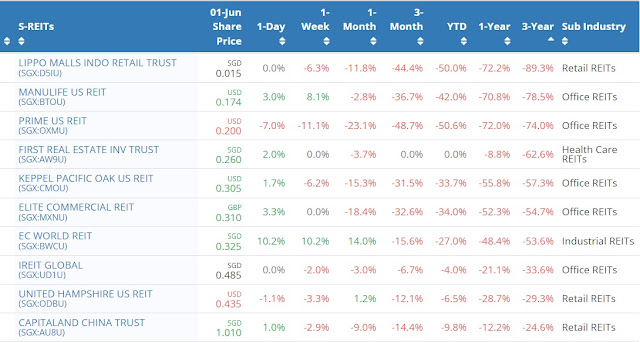Performance of Singapore Listed REITs in the Past 1 and 3 Years
One month ago, I did a comparison of the performance of REITs i hold in my portfolio in this post, evaluating the impact of high interest rate environment of the REITs' earnings and distribution per unit. In this post, I am going to just look at the performance of the share prices of the REITs in the short term (past 1 year) and medium term (past 3 years). The following data are all taken from sg investors.
Year-to-Date Performance (9 REITs in the Green)
Year to date, industrial/logistics and retail REITs with at least a part of their properties in Singapore seem to perform better than others (with the exception of Cromwell European REIT), up by 0.9% to 18.6%. However, performance is not consistent as retail REITs like Lendlease REIT and industrial REIT like Aims Apac REIT are not in the list. One possible reason for Aims Apac REIT to be excluded from this list is possibly due to the price correction after the announcement of private placement and preferential offerings of shares at a lower price, which caused slight price adjustment downwards to reflect the average price after the enlarged share base.
Year-to-Date Performance (Top 10 REITs in the Red)
As seen above, year to date, REITs focusing in commercial real estate, with majority of their properties outside of Singapore are the worst hit, from -9.4% to a staggering -50.6%! That is definitely due to the negative outlook that many prominent figures had openly mentioned for the sector in the past few months, like Charlie Munger and Elon Musk.
One-Year Performance (Only 3 REITs in the Green)
In the past one year, performance in the REITs sector has largely been muted, as only 3 REITs are in the green, from 0.5% to 2.9%, which is largely flat.
One-Year Performance (Top 10 REITs in the Red)
As seen above, in the past one year, REITs focusing in commercial real estate, with majority of their properties outside of Singapore are the worst hit, from -26.9% to an eye-popping -72.2%! Exactly one year ago, it was the start of the rapid interest rate increase. Through the year, the rapid climb in interest rates had impacted all REITs, regardless of sector. Nonetheless, some remained more resilient than others. Mapletree and Capitaland sponsored REITs seemed stronger than others, as such, the quality of sponsors and the size of the REITs would still be able to instill more confidence in investors compared to smaller REITs.
Three-Year Performance (Only 8 REITs in the Green)
In the medium term of 3 years, it is evident that retail and hospitality REITs are taking up majority of the top spots, up by 3% to as much as 28.4%. This is largely due to the recovery from the post-covid period, where retail and hospitality REITs benefit from the opening up of international borders and 'revenge travel' takes place. Sabana Industrial REIT and Frasers Logistics and Commercial Trust seem to be the outliner in this list, because they were more badly affected by the pandemic compared to other industrial and logistics REITs and hence mathematically, the calculation were based on a low share price 3 years ago.
Similarly, it is the mainly the overseas commercial REITs that took the top spots in the list, falling from -24.6% to a disastrous -89.3%. Seems like these REITs have not recovered at all post covid.









Comments
Post a Comment